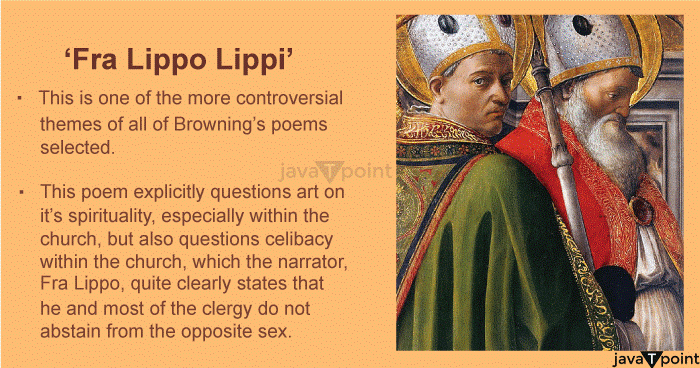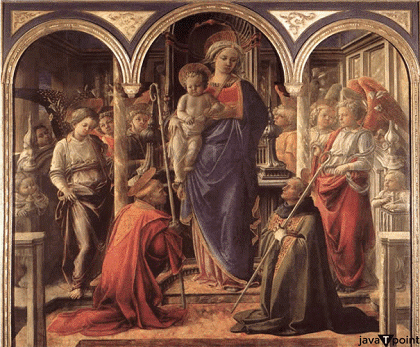Fra Lippo Lippi SummaryAbout the PoetRobert Browning was an English poet and dramatist known for his theatrical monologues. He was born on May 7, 1812, and died on December 12, 1889. His work was notable for its sarcasm, characterization, dark humor, societal critique, historical settings, and complicated vocabulary and grammar. Pauline (1833) and Paracelsus (1835), two of his early long poems, were warmly appreciated. Nonetheless, his reputation suffered for a while - his 1840 poem Sordello was thought to be purposefully disappointing - and it took him over a decade to recover. He had departed from Shelleyan and adopted a more intimate strategy. In 1846, he married fellow poet Elizabeth Barrett and moved to Italy. By the time she died in 1861, he had completed Men and Women (1855). His epic poem The Ring and the Book (1868-1869) and dramatis personae (1864) established him as a renowned poet. He was considered a knowledgeable philosopher-poet when he died in 1889, contributing to Victorian social and political conversations. 
IntroductionFra Lippo Lippi is a theatrical monologue written by Victorian poet Robert Browning in 1855, initially published in his book Men and Women. Browning describes a 15th-century real-life painter, Filippo Lippi, throughout this poem. The poem examines whether art should be truthful to life or an idealized representation of life. The poem is written in a non-rhyming manner in blank verse. The Church's effect on art is a secondary subject in the theatrical monologue. Although Fra Lippo paints real-life scenes, the Church orders him to rewrite most of his work, telling him to portray the soul rather than the flesh. "Paint the soul first, then the legs and arms!" Aside from the Church's goal to improve how holiness is depicted visually, this poem seeks to develop a means of considering the secular with the religious regarding how a "holy" person might live his life. Secondary characters also discuss celibacy, church law, and the canon. The Theme of the Poem"Fra Lippo Lippi" conveys not just Browning's subject's opinion of the purpose of painting but also the poet's views on the role of poetry. Both a painter and a poet have the ability to imagine. The question is how they should relate to the real world and the ideal ones they can predict. The prior and his learned colleagues believe that Fra Lippo Lippi's figures are too accurate, that by painting so realistically, the painter will cause his viewers to focus on human bodies and thus become distracted from their genuine concern, their souls. Bodies pass away, but spirits live on. Both Browning and Fra Lippo Lippi share this perspective. The modest monks will receive the painter's work. They like seeing individuals they know; unlike the previous, they enjoy life naturally. According to Fra Lippo Lippi, beauty cannot weaken devotion. In lines 217-221, he states that by responding to the beauty of God's creation, humanity is moved to thank God and become mindful of their souls. Fra Lippo Lippi admits after the segment that he has questions about whether he or the Church is correct, but while painting, he always remembers the God of Genesis, creating Eve in the Garden of Eden. God created flesh, which cannot be evil. In the second half, Fra Lippo Lippi advances a new argument. Realistic paintings draw attention to real-life beauty that people may otherwise miss, "things we have passed/perhaps a hundred times and never cared to see." In this approach, the artist inspires others to glorify their creator. The central theme of "Fra Lippo Lippi," thus, is that the goal of painting should be to show the natural beauty of God's creation while simultaneously revealing the hidden spiritual beauty of his creatures. Browning decided to do the same in his poems. As Fra Lippo Lippi talks to his sympathetic audience, he transforms from a running monk in a dirty robe, detained by the watch in an unpleasant district of his city, to a passionate artist and a man of spiritual greatness. SummaryThe poem opens with the narrator, painter, and monk Lippo Lippi, captured by several authority figures while strolling his town's red-light district. As he begins, he is violently confronted by a police officer. He accuses them of being overly concerned and claims he should not be criticized. He is not released until he mentions "Cosimo of the Medici" (from Florence's royal dynasty) as a local friend. He then addresses himself mainly to the band's leader, introducing himself as the great painter and implying that they are everyone, including himself, too quick to bend down to what authority persons offer. Now that he is free, he proposes that the listener leave his subordinates to their own devices. Then he describes how he had spent the previous three weeks locked up in his chamber until he heard a bunch of cheerful dancers passing by and used a ladder to get down the streets to have fun. He was caught while having pleasure, and he defends himself to the essential listener, saying, "What am I a beast for?" if not to chase his violent cravings. Lippo then begins to recount his life narrative. He was orphaned as a baby and malnourished until his aunt abandoned him in a monastery. When the monks asked whether he was prepared to leave the world in service of monkhood, Lippo quickly agreed because the world's abandonment meant a regular source of food at the convent. Even at eight, he quickly adjusted to the "idleness" of a monk's life, although he lacked in any issues they assigned him. 
His one gift was the ability to sketch people's features, partly because, as a malnourished boy, he was given an extraordinary insight into the intricate details that divided one face from another and how those faces represented distinct qualities. Instead of studying at the convent, he devoted himself to doodling and sketches until the Prior saw his potential and appointed him as the monastery's artist. As the monastery's artist, Lippo depicted many scenarios based on real-life events. The average monk adored his work because it contained scenes from their everyday existence. However, "the Prior and the learned" disregard Lippo's attention to practical issues, stating that the artist's mission is to escape the body and strive to disclose the spirit rather than to give "homage to the perishable clay" of flesh and body. They believe he paints more religious images, emphasizing praise and saintliness over ordinary life. Lippo tells his audience that representations of the body may reveal the spirit since "simple beauty" is "about the best thing God invents." Lippo sees this as the significant tension in his otherwise privileged existence: when he wants to paint things as they are, his teachers insist on his painting life from an ethical perspective. As much as he dislikes it, he must agree to their wants to remain successful, and therefore Lippo must pursue prostitutes and other unpleasant activities, such as the one he got caught up in at the opening of the poem. As a poor child in love with life, he cannot easily ignore his creative drive to express life as he sees it. He then tells the audience what generations of artists owe each other and how an artist who creates new ground must constantly challenge tradition. He cites a painter named Hulking Tom, who learns under him and whom Lippo feels would further alter creative practice by seeking reality as he did. He asks his audience if it is better to "paint [things] just as they are" or strive to improve God's handiwork. He claims that even when recreating nature, the artist can let people perceive items they previously took for granted freshly. He gets angry as he considers how his instructors have ruined the purpose of painting but hastily apologizes to avoid upsetting the policeman. He then informs his audience about his strategy for pleasing his masters and himself. He plans to create a massive piece of religious art that depicts God, the Madonna, and "of course, a saint or two." He will, however, insert a photograph of himself witnessing the scene in the painting's corner. He then dreams intensely about how a "sweet angelic slip of a thing" in the painting would approach him, complimenting his creativity and authorship, until the "hothead husband" arrives and compels Lippi to hide in the picture. Lippo waves farewell to his listener and returns home. AnalysisAnother of Browning's theatrical monologues, "Fra Lippo Lippi," appeared in the 1855 book Men and Women. Fra (Brother) Lippo Lippi was a Florentine monk from the fourteenth century. He was a well-known painter, and Browning was most likely familiar with his works during his stay in Italy. "Fra Lippo Lippi" introduces us to the monk as he is interrogated by Medici watchmen who have arrested him late at night. Lippo has nothing to fear from the guards because Cosimo de Medici is the man who supports him, but he has been out drinking and is plainly in the mood to chat. He shares the difficulties of monastic life with the men: he is compelled to keep his interactions with women hidden, and his superiors are constantly fighting his good spirits. But Lippo's most important arguments are on the nature of art: should it be realistic and faithful to life or idealistic and instructive? Should Lippo's paintings of saints be compared to Prior's mistress and neighborhood men, or should they recall unimaginable surrealism? "Which types of art are most suited to religious purposes? Should art ever serve religion? Lippo's rambling speech addresses all of these concerns. |
 For Videos Join Our Youtube Channel: Join Now
For Videos Join Our Youtube Channel: Join Now
Feedback
- Send your Feedback to [email protected]
Help Others, Please Share









